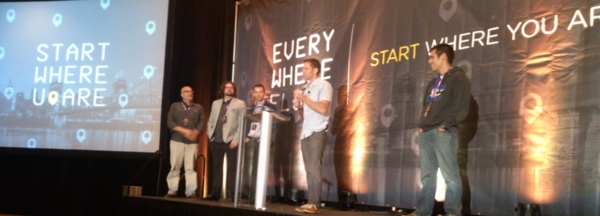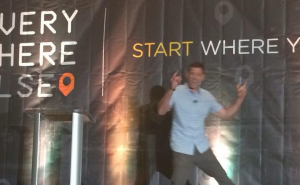
Rob Woodbridge gave an interesting talk during Everywhere Else Cincinnati. “The Top 4 Mobile Business Models and how to Optimize Them for Revenue” was a title that may seem bland and boring. So many times at conferences you see sessions entitled things like, “SEO for eCommerce,” or “Optimize Your Facebook page for Conversions,” or “The Perfect Investor Pitch,” or some such thing. More often that not, these are the sessions that attendees leave after 5-10 minutes out of boredom. However, this session ended up being one of the most enjoyable of the conference.

In the first, of what actually proved to be many, sessions that required audience participation, Woodbridge called four audience members to the stage – interestingly one of the participants was Jared Steffes who spoke the following day. Woodbridge lined the four up on the stage, three on one end and one on the other and Woodbridge in the middle (Not sure how I did not get a picture of the formation, but @_everywhereelse got a pretty good one here). This formation represented what Woodbridge dubbed the May-Boss-Weil continuum of mobile apps.
May-Boss-Weil Continuum
Woodbridge’s continuum is a really good way to think about the life-cycle of mobile apps. There are more than 1.7 billion applications available in the various app stores and with the average number of apps per smartphone at 41. Woodbridge argued that the great majority of these apps are crap. But, some really useful applications live on forever.
May
The May of the continuum represented the Mayfly. The Mayfly has the shortest lifespan of any animal on the planet, lasting from one to three days. This section of the continuum contains the majority of mobile applications, and was represented with the three audience members. This end is were the one-off apps live: the fart noise makers and the knock offs of Angry Birds.
Weil
The Weil in the continuum is named for Ray Kurzweil, Director of Engineering at Google who argues that in the near future, technology will enable humans to live indefinitely. This end of the continuum is where the Google Maps and Twitters and Evernotes live, possibly forever.
Boss
The Boss is named for the Boss himself, Bruce Springsteen. The Boss sits right in the middle because, as Woodbrige put it, he is not really retired and he is not really going 100% anymore; he is neither too old, or too young, just the Boss. Woodbridge argued that this is the part of the continuum that application developers should shoot for.
The continuum holds because, Woodbridge went on, application developers are chasing the almighty download. This is a losing strategy, and there are many other metrics that are a much better indicator of quality than downloads; namely average monthly/weekly/daily usage. According to Woodbridge, “Chasing downloads is chasing death.” Rather, the best approach is to build something that is great, and monetize in one of the four ways outlined in Woodbridge’s discussion:
1. Brand Reinforcement
This strategy really only applies to established companies and works best for physical products. Woodbridge brought up the examples of the Krispy Kreme and Stella Artois applications. The Krispy Kreme app lets users know when they are close to a store and will notify the user when the donuts are “Hot Now.” The Stella application allows users to find close bars that serve Stella and sort by various filters such as distance and rating. This value-add approach is a great way for established brands to engage mobile.
2. Freemium
For the freemium approach to work, you must build a really awesome product that people use. Evernote is the best example of a freemium application. The success of Evernote particularly, and the freemium model more broadly, lies in the usefulness of a product. The oft-quoted remark from Evernote’s CEO Phil Libin speaks to this: “The easiest way to get 1 million people paying is to get 1 billion people using.” Build something awesome, and people will pay for an upgrade.
3. Premium
This one is fairly simple, just charge for the app. Be it $.99 or $999.99, charging an upfront fee is a simple way to monetize an application.
4. Data
This is a unique approach. Woodbridge brought up the example of Ubiqui Health. Prior to launching any product, Ubiqui surveyed doctors and patients about health issues, particularly which issues with a real lack of information and data available. It soon became clear that there was a real lack of data around migraines. Thus, they built a migraine tracking application and sold the data to pharmacies and doctors. There are plenty of ways to employ this approach, but it takes some creative thinking.
While, certainly, there are many different avenues through which to monetize a mobile application, the four highlighted by Woodbridge offer the greatest chance at success. Woodbridge finished on a note that we can all agree to, “Banner ads fu*king suck!”
Andrew Thompson is the Managing Editor of TechFaster




Andrew – THANK YOU for writing this up and thanks for sticking around longer than 5 minutes, means a ton!